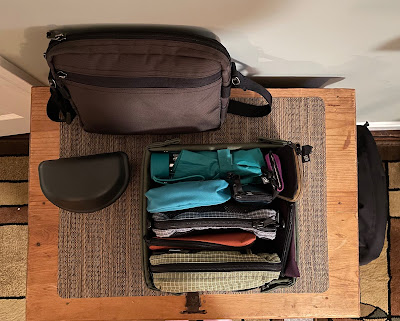Here is a review of the Tom Bihn Truck, made, for the first time, in "domestic organic cotton canvas — grown, woven, and dyed right here in the U.S.A."
I was provided a review copy of this bag for free, in exchange for my feedback.
It is currently offered in Natural (undyed), Santa Cruz (electric purple-blue), and Talus (dark grey/pastel black). I requested the "natural", and somehow thought it would be a grey or olive color, but not at all -- it's a creamy white! It is quite nice: very stiff (ie, holds its shape), and pleasant to touch, without any of the shininess of the ballistic fabric. To be honest, if I'd known it was going to be white, though, I might have requested it in the dark grey, because I have an incredible talent for getting things dirty. However, in its pristine state, I think it is my favorite of the three choices on offer.
The purple/blue color is already garnering a lot of interest, but I prefer more muted colors.
This is the first Tom Bihn truck I've owned in this size. I do love the idea of the natural fabrics. I don't know if I'd take this one to the grocery store, but will find a use for it indoors. It's nicer than the ballistic versions, so it could be on standby for bringing drinks and treats to a get-together, particularly with that pretty moon label!
A close-up of the fabric to show the texture:
A top view. Again, I'm kind of scared of the white, but it's certainly easy to see what's inside! I'm also enjoying the contrast of the black piping.
This version of the Truck seems to have the same stiff base as the ones in Ballistic or Cordura, and the compartments and piping give it structure.
It's funny to see the strong feelings about the labels. Some people seek out black ones (count me in on that, particularly on bags with a black exterior) and someone else managed to cut theirs off and replace it with the traditional red airplane one. I personally don't mind any of them, and the red airplane is great, but not if it clashes (ie, with an orange or blue bag). When I make color choices I'm looking at the totality of inside fabric, outside fabric and label. For this series, I think the moon label goes well with the grey, white or blue/purple.
Final note: This is not meant to be an exhaustive review showing all the functions of the Truck, a product which has been out for a while. Tom Bihn has gathered many great photos on uses and ideas, and there's not much point in my trying to recreate all that. Check out the regular Truck product page, as well as the one for the Organic Cotton Truck.































